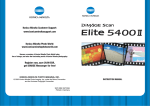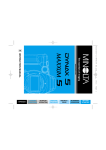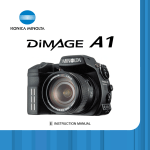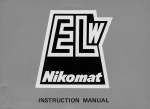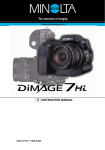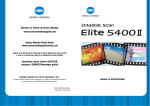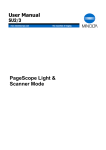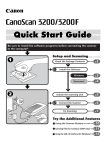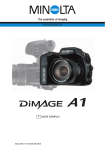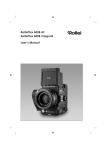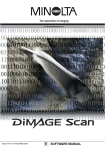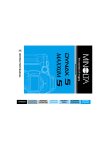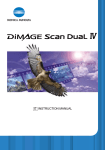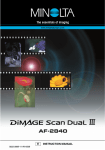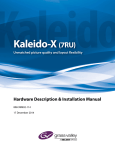Download Minolta Dimage Scan Dual III Film Scanner
Transcript
E INSTRUCTION MANUAL COLOR BEFORE YOU EXAMPLES Tone-curve corrections By selecting individual color channels on the tone curve, adjustments to the overall color of an image can be made. In this example, the image is too yellow. By moving the blue curve up, the image looks more neutral. For more on tone curve corrections, see page 71. BEGIN Thank you for purchasing this Minolta product. Please take the time to read through this instruction manual so you can enjoy all the features of your new scanner. This manual contains information regarding products introduced before October, 2002. To obtain information for products released after this date, contact a Minolta service facility listed on the back cover of this manual. This product is designed to work with accessories manufactured and distributed by Minolta. Using accessories or equipment not endorsed by Minolta may result in unsatisfactory performance or damage to the product and its accessories. This instruction manual does not provide instruction in the basic operation of the personal computers, or the basic operation of Windows or Macintosh operating systems; refer to the manuals supplied with the computer. The examples in this manual use Windows software. The appearance of the screens may differ from the examples when using Macintosh or other Windows operating systems. Every precaution has been taken to ensure the accuracy of this material. Specifications in this manual are based on the latest information available at the time of printing and are subject to change without notice. Minolta is not responsible for any loss or damage caused by the use of this software. This instruction manual may not be copied either in part or in its entirety without the prior permission of Minolta. Microsoft, Windows, Windows 98, Windows Me, Windows 2000 Professional, and Windows NT are registered trademarks of the Microsoft Corporation. Macintosh, Apple, and Power Macintosh are registered trademarks of Apple Computer, Inc. Adobe and Photoshop are registered trademarks of Adobe Systems Incorporated. Other corporate and product names are the trademarks and registered trademarks of their respective companies. Selective-color palette In the original image, the colors were muted making the whole scene flat. By subtracting cyan from the red channel, the bridge and faint details in the clouds could be accentuated. The cloud detail was further enhanced by subtracting yellow from the blue channel. For more on the selective color palette, see page 79. Before After 2 3 TABLE OF CONTENTS Color examples . . . . . . . . . . . . . . . . . . . . . . . . . . . . . . . . . . . . . . . . . . . 2 Before you begin . . . . . . . . . . . . . . . . . . . . . . . . . . . . . . . . . . . . . . . . . . 3 For proper and safe use. . . . . . . . . . . . . . . . . . . . . . . . . . . . . . . . . . . . . 8 Getting started . . . . . . . . . . . . . . . . . . . . . . . . . . . . . . . . . . . . . . . . . . . 10 The package contents . . . . . . . . . . . . . . . . . . . . . . . . . . . . . . . . 10 System Requirements. . . . . . . . . . . . . . . . . . . . . . . . . . . . . . . . . 10 Installation . . . . . . . . . . . . . . . . . . . . . . . . . . . . . . . . . . . . . . . . . 12 Before installing the utility software . . . . . . . . . . . . . . . . . . 12 Installing the utility software – Windows . . . . . . . . . . . . . . . 12 Installing the utility software – Macintosh . . . . . . . . . . . . . . 14 Installing Adobe Photoshop Elements . . . . . . . . . . . . . . . . 16 Launching the scanner utility from Photoshop Elements. . . 16 Names of parts . . . . . . . . . . . . . . . . . . . . . . . . . . . . . . . . . . . . . . 17 Before scanner setup . . . . . . . . . . . . . . . . . . . . . . . . . . . . . . . . . 18 Connecting the USB cable . . . . . . . . . . . . . . . . . . . . . . . . . . . . . 18 Connecting the AC adapter . . . . . . . . . . . . . . . . . . . . . . . . . . . . . 19 Turning on the scanner . . . . . . . . . . . . . . . . . . . . . . . . . . . . . . . . 19 Turning off the scanner . . . . . . . . . . . . . . . . . . . . . . . . . . . . . . . . 19 Disconnecting the scanner . . . . . . . . . . . . . . . . . . . . . . . . . . . . . 19 Loading the film holders . . . . . . . . . . . . . . . . . . . . . . . . . . . . . . . . . . . . 20 Film formats . . . . . . . . . . . . . . . . . . . . . . . . . . . . . . . . . . . . . . . . 20 Loading the film . . . . . . . . . . . . . . . . . . . . . . . . . . . . . . . . . . . . . 20 Handling film . . . . . . . . . . . . . . . . . . . . . . . . . . . . . . . . . . . 20 Where is the emulsion? . . . . . . . . . . . . . . . . . . . . . . . . . . . 20 Loading 35mm film strips. . . . . . . . . . . . . . . . . . . . . . . . . . 20 Loading mounted slides. . . . . . . . . . . . . . . . . . . . . . . . . . . 21 Loading a film holder into the scanner. . . . . . . . . . . . . . . . . . . . . 22 Using the FH-U1 and SH-U1 film holders. . . . . . . . . . . . . . 22 Using the APS Adapter AD-10 (sold separately) . . . . . . . . . 22 Ejecting a film holder . . . . . . . . . . . . . . . . . . . . . . . . . . . . . 23 Easy Scan Utility . . . . . . . . . . . . . . . . . . . . . . . . . . . . . . . . . . . . . . . . . 24 Launching the Easy Scan Utility . . . . . . . . . . . . . . . . . . . . . . . . . 24 Using the Easy Scan Utility. . . . . . . . . . . . . . . . . . . . . . . . . . . . . 25 DiMAGE Scan Dual III Utility . . . . . . . . . . . . . . . . . . . . . . . . . . . . . . . . 30 DiMAGE Scan Dual III Utility – Basic scanning. . . . . . . . . . . . . . . . . . . 31 Launching the DiMAGE Scan Dual III Utility . . . . . . . . . . . . . . . . 31 Launching the utility from an image-processing application . . . 31 Selecting the film format and type . . . . . . . . . . . . . . . . . . . . . . . . 31 Index scan . . . . . . . . . . . . . . . . . . . . . . . . . . . . . . . . . . . . . . . . . 32 Main window and index scan tab . . . . . . . . . . . . . . . . . . . . 32 Making an index scan . . . . . . . . . . . . . . . . . . . . . . . . . . . . 33 Canceling the index scan. . . . . . . . . . . . . . . . . . . . . . . . . . 33 Selecting index thumbnails . . . . . . . . . . . . . . . . . . . . . . . . 33 Flip and rotate images . . . . . . . . . . . . . . . . . . . . . . . . . . . . . . . . 34 Fit-to-window button . . . . . . . . . . . . . . . . . . . . . . . . . . . . . . . . . . 35 Prescan . . . . . . . . . . . . . . . . . . . . . . . . . . . . . . . . . . . . . . . . . . . 36 Main window and prescan tab . . . . . . . . . . . . . . . . . . . . . . 36 Making a prescan . . . . . . . . . . . . . . . . . . . . . . . . . . . . . . . 37 Grab tool . . . . . . . . . . . . . . . . . . . . . . . . . . . . . . . . . . . . . . 37 Magnifying tool . . . . . . . . . . . . . . . . . . . . . . . . . . . . . . . . . 37 Auto cropping . . . . . . . . . . . . . . . . . . . . . . . . . . . . . . . . . . 37 CHP button (APS film). . . . . . . . . . . . . . . . . . . . . . . . . . . . 38 Manual cropping . . . . . . . . . . . . . . . . . . . . . . . . . . . . . . . . 38 Prescanning the cropped area . . . . . . . . . . . . . . . . . . . . . . 38 Auto Dust Brush – Removing the affect of dust . . . . . . . . . . . . . . 39 Pixel Polish – Correcting images automatically . . . . . . . . . . . . . . 40 Main window and Pixel Polish tab . . . . . . . . . . . . . . . . . . . 40 Making the final scan using Jobs . . . . . . . . . . . . . . . . . . . . . . . . 42 Quitting the DiMAGE Scan Dual III Utility . . . . . . . . . . . . . . . . . . 43 (Continued on next page.) 4 5 TABLE OF CONTENTS DiMAGE Scan Dual III Utility – Advanced scanning . . Setting scanner preferences . . . . . . . . . . . . . . . Exposure-control tab. . . . . . . . . . . . . . . . . . . . . Saving exposure settings. . . . . . . . . . . . . Loading exposure settings . . . . . . . . . . . . More index scan functions . . . . . . . . . . . . . . . . Reverse frame order . . . . . . . . . . . . . . . . Saving the index images . . . . . . . . . . . . . Saving an index file . . . . . . . . . . . . . . . . . Loading an index file . . . . . . . . . . . . . . . . Autoexposure control – More prescan functions AE area selection . . . . . . . . . . . . . . . . . . AE lock . . . . . . . . . . . . . . . . . . . . . . . . . . Focusing the scanner – More prescan functions Point AF (Autofocus) . . . . . . . . . . . . . . . . Manual focus. . . . . . . . . . . . . . . . . . . . . . Inputting scan settings manually . . . . . . . . . . . . Scan setting window . . . . . . . . . . . . . . . . About resolution and output size . . . . . . . Scan setting examples . . . . . . . . . . . . . . Saving scan settings as a Job. . . . . . . . . . . . . . Deleting a Job . . . . . . . . . . . . . . . . . . . . . . . . . Custom Wizard. . . . . . . . . . . . . . . . . . . . . . . . . Color matching . . . . . . . . . . . . . . . . . . . . . . . . . Setting the output color space . . . . . . . . . Setting the monitor ICC profile. . . . . . . . . Scanner color profiles . . . . . . . . . . . . . . . Color matching recommendations . . . . . . 6 . . . . . . . . . . . . . 44 . . . . . . . . . . . . . 44 . . . . . . . . . . . . . 46 . . . . . . . . . . . . . 47 . . . . . . . . . . . . . 47 . . . . . . . . . . . . . 48 . . . . . . . . . . . . . 48 . . . . . . . . . . . . . 49 . . . . . . . . . . . . . 49 . . . . . . . . . . . . . 49 . . . . . . . . . . . . . 50 . . . . . . . . . . . . . 51 . . . . . . . . . . . . . 51 . . . . . . . . . . . . . 52 . . . . . . . . . . . . . 52 . . . . . . . . . . . . . 53 . . . . . . . . . . . . . 54 . . . . . . . . . . . . . 54 . . . . . . . . . . . . . 55 . . . . . . . . . . . . . 56 . . . . . . . . . . . . . 57 . . . . . . . . . . . . . 57 . . . . . . . . . . . . . 58 . . . . . . . . . . . . . 60 . . . . . . . . . . . . . 60 . . . . . . . . . . . . . 62 . . . . . . . . . . . . . 62 . . . . . . . . . . . . . 63 DiMAGE Scan Dual III Utility – Image processing. . . . . . . . . . . . . . . . . 64 Image processing tools . . . . . . . . . . . . . . . . . . . . . . . . . . . . . . . . 64 Main window and image-correction tab . . . . . . . . . . . . . . . 64 Guide to image-processing tool . . . . . . . . . . . . . . . . . . . . . 65 Undoing and redoing image corrections . . . . . . . . . . . . . . . 66 Tracking image corrections – Snapshot button. . . . . . . . . . 66 Comparing pre and post correction images . . . . . . . . . . . . 67 Saving image corrections . . . . . . . . . . . . . . . . . . . . . . . . . 67 Loading image-correction Jobs . . . . . . . . . . . . . . . . . . . . . 68 Variation palette . . . . . . . . . . . . . . . . . . . . . . . . . . . . . . . . 69 Brightness, contrast, and color balance palette . . . . . . . . . 70 Tone curve and histogram corrections . . . . . . . . . . . . . . . . 71 Tone curve and histogram palette . . . . . . . . . . . . . . . . . . . 72 Using tone curves . . . . . . . . . . . . . . . . . . . . . . . . . . . . . . . 72 Drawing tone curves by freehand . . . . . . . . . . . . . . . . . . . 73 A short guide to tone curve corrections . . . . . . . . . . . . . . . 74 Histogram corrections . . . . . . . . . . . . . . . . . . . . . . . . . . . . 76 Tone curve / histogram auto setting . . . . . . . . . . . . . . . . . . 77 White, gray, and black point corrections . . . . . . . . . . . . . . . 78 Setting the white and black-point values . . . . . . . . . . . . . . 79 Selective-color palette . . . . . . . . . . . . . . . . . . . . . . . . . . . . 79 Unsharp mask . . . . . . . . . . . . . . . . . . . . . . . . . . . . . . . . . . 80 Hue, saturation, and lightness palette . . . . . . . . . . . . . . . . 81 Job file lists . . . . . . . . . . . . . . . . . . . . . . . . . . . . . . . . . . . . . . . . . . . . . 82 35mm film . . . . . . . . . . . . . . . . . . . . . . . . . . . . . . . . . . . . . . . . . 82 APS film . . . . . . . . . . . . . . . . . . . . . . . . . . . . . . . . . . . . . . . . . . . 83 Installed files and folders . . . . . . . . . . . . . . . . . . . . . . . . . . . . . . . . . . . 84 Troubleshooting and technical support . . . . . . . . . . . . . . . . . . . . . . . . . 86 Pixel Polish and Mac OS . . . . . . . . . . . . . . . . . . . . . . . . . . . . . . 87 Checking scanner installation (Windows) . . . . . . . . . . . . . . . . . . 87 Technical support . . . . . . . . . . . . . . . . . . . . . . . . . . . . . . . . . . . . 88 Warranty and product registration . . . . . . . . . . . . . . . . . . . . . . . . 88 Technical specifications . . . . . . . . . . . . . . . . . . . . . . . . . . . . . . . . . . . . 89 An introduction to color . . . . . . . . . . . . . . . . . . . . . . . . . . . . . . . . . . . . 90 Primary (RGB) and secondary (CMYK) colors. . . . . . . . . . . . . . . 90 Complementary colors . . . . . . . . . . . . . . . . . . . . . . . . . . . . . . . . 90 Color examples . . . . . . . . . . . . . . . . . . . . . . . . . . . . . . . . . . . . . . . . . . 91 7 FOR PROPER AND SAFE USE Read and understand all warnings and cautions before using this product. WARNING • Use only within the voltage range specified on the unit. Inappropriate current may cause damage or injury through fire or electric shock. • Only use the AC adapter (model specified by Delta Electronics, Inc. ADP-20LB or Ya Hsin Industrial Co., Ltd. 019-240840) supplied with the product within the voltage range indicated on the adapter unit. Using other adapters or an inappropriate current may cause damage or injury through fire or electric shock. • Do not disassemble this product. Electric shock may cause injury if a high-voltage circuit inside the product is touched. Take the product to a Minolta Service Facility when repairs are required. • Immediately unplug the unit and discontinue use if the product is dropped or subjected to an impact in which the interior is exposed. The continued use of a damaged product may cause injuries or fire. • Store this product out of reach of children. Be careful when around children not to harm them with the product or parts. • Do not operate this product or handle the DC cord with wet hands. Do not place a container with liquid near the product. If liquid comes in contact with the product, immediately unplug the unit. The continued use of a product exposed to a liquid may cause damage or injury through fire or electric shock. • Do not insert hands, inflammable objects, or metal objects such as paper clips or staples into this product. It may cause damage or injury through fire or electric shock. Discontinue use if an object enters the product. • Do not use the product near inflammable gases or liquids such as gasoline, benzine, or paint thinner. Do not use inflammable products such as alcohol, benzine, or paint thinner to clean the product. The use of inflammable cleaners and solvents may cause an explosion or fire. • When unplugging the unit, do not pull on the DC cord. Hold the AC adapter unit when removing the DC cord from an outlet. • If the product emits a strange odor, heat, or smoke, discontinue use. Immediately unplug the product. The continued use of a damaged product or part may cause injuries or fire. • Take the product to a Minolta Service Facility when repairs are required. CAUTION • This product should only be operated in the upright position. Inappropriate placement may result in fire. • Damage or injury through fire or electric shock may result if the product is used or stored in the following conditions: In humid or dusty environments In direct sunlight or hot environments In smoky or oily areas In unventilated areas On unstable or unlevel surfaces 8 • • • • Insert the plug securely into the electrical outlet. Do not use if the cord is damaged. Do not cover the AC adapter. A fire may result. Do not obstruct access to the AC adapter; this can hinder the unplugging of the unit in emergencies. • Unplug the product when cleaning or when the unit is not in use for long periods. • Periodically check that the plug is clean. Dust and dirt that may collect between the prongs of the plugs may result in fire. Additional cautions: • Do not move, obstruct, or touch the film holder when scanning. The product or scanned images can be damaged. • Do not use a brush or air brush to clean the interior of the product. As an ENERGY STAR Partner, Minolta has determined that this product meets the ENERGY STAR guidelines for energy efficiency. This mark certifies that this product meets the requirements of the EU (European Union) concerning interference causing equipment regulations. CE stands for Conformité Européenne. Dual III This device complies with Part 15 of the FCC Rules. Operation is subject to the following conditions: (1) This device may not cause harmful interference, and (2) this device must accept any interference received, including interference that may cause undesired operation. Do not remove the ferrite cores from the cables. This Class B digital apparatus complies with Canadian ICES-003. Cet appareil numérique de la classe B est conforme à la norme NMB-003 du Canada. Tested by the Minolta Corporation 101 Williams Drive Ramsey, New Jersey 07446 USA The sound pressure level is less than 70dB according to ISO 3744 or ISO 7779. 9 GETTING STARTED Follow the steps below to set up the scanner. 1 Check the package contents (p. 10) 2 Check the system requirements (p. 10) 3 Install the utility software (p. 12) 4 Connect the USB cable (p. 18) 5 Connect the AC adapter (p. 19) 6 Turn on the scanner (p. 19) The package contents Check the packing list before using this product. If any items are missing, immediately contact your dealer. 1 Instruction manual 9 AC adapter The adapter unit varies with destination: 2 Warranty card AC-U21 for use in North America, Taiwan, and 3 Scanner unit Japan. 4 35mm film holder FH-U1 AC-U22 for use in continental Europe, 5 Slide mount holder SH-U1 Oceania, and Asia (except Hong Kong, China, 6 USB cable UC-2 Taiwan, and Japan). 7 DiMAGE Scan Dual III CD-ROM AC-U23 for use in England, Hong Kong 8 Adobe Photoshop Elements CD-ROM AC-U24 for use in China. * The CPU and RAM must satisfy the requirements of the operating system. * Application software must be guaranteed by the manufacturer to work with the operating system. * The USB interface must be guaranteed by the manufacturer to work with the operating system. * The software may freeze or an error may occur if the operating system's stand-by (sleep) function activates. Turn the function off before using the utility software. * The RAM requirements refer to the physical memory available without the use of memory management tools or virtual memory. * Check the Minolta web site for the latest compatibility information: North America: http://www.minoltausa.com Europe: http://www.minoltaeurope.com/pe/digital/languages_stage.html CPU, RAM, and hard-disc space requirements with 16-bit color depth, Auto Dust Brush (dust-removal function), and Pixel Polish (automatic image-correction function) are as follows: IBM PC/AT compatible computers Recommended requirements in parenthesis 16-bit color depth Contact your dealer for AC adapter models for other countries. System Requirements To use the scanner, the computer system must meet the following requirements: IBM PC/AT compatible computers Macintosh computers Pentium 166MHz or later processor. PowerPC G3 or later processor. Windows 98, 98 Second Edition, 2000 Professional, Me, or XP. Mac OS 8.6 to 9.2.2, Mac OS X v10.1.3 to v10.1.5., and v10.2.1 A minimum of 64MB of actual RAM. A minimum of 64MB of RAM in addition to the requirements for the Mac OS and applications. 100MB or more of free hard disk space. A monitor with 1024x768 pixels or greater is recommended. A monitor with 640 x 480 pixels can also be used. A 16-bit or greater color monitor: High Color or medium color quality (Windows XP). A monitor with 32,000 colors or more. The TWAIN driver software has been tested for use with Photoshop ver. 5.5, 6.0.1, 7.0, Photoshop Elements, Paint Shop Pro 7.0, and Corel PHOTO-PAINT 10.0. The plug-in driver software has been tested for use with Photoshop ver. 5.5, 6.0.1, 7.0, and Photoshop Elements. USB port as standard interface, Adaptec: USB2connect 3100, USB2connect 5100, DuoConnect. Belkin: Hi-speed USB 2.0 5-Port PCI Card, USB 2.0 Hi-Speed 2-Port PCI Card. Standard USB port supplied by Apple Computer. 10 Auto Dust Brush or Pixel Polish 16-bit plus Auto Dust Brush Pentium 166MHz (Pentium II) or later processor. Pentium 166MHz (Pentium III) or later processor. 64MB (128 MB) of actual RAM. 128MB with Windows XP 128 MB (256 MB) of actual RAM. 200MB (400 MB) of free hard-disk space. 300MB (600 MB) of free hard-disk space. 500MB (1GB) of free hard-disk space. Macintosh computers Recommended requirements in parenthesis 16-bit color depth Power PC G3 or later processor. Auto Dust Brush or Pixel Polish 16-bit plus Auto Dust Brush Power PC G3 (PowerPC G4) or later processor. A minimum of 128MB (256MB) of RAM in addition to the requirements for the Mac OS and applications. 200MB (400 MB) of free hard-disk space. 300MB (600 MB) of free hard-disk space. 500MB (1GB) of free harddisk space. To use the plug-in with Photoshop or Photoshop Elements on Mac OS 8.6 - 9.2.2, add the above memory requirements to Photoshop’s suggested application memory allocation. 11 GETTING STARTED Installation Before installing the utility software RAM-stationed programs such as anti-virus or installation-monitoring software may cause the installer to fail. Remove or disable these programs before installing the scanner software. Reinstall or enable the software when the installation is complete. Do NOT connect the scanner to a computer before installing the software; if the scanner is connected to the computer before the software is installed, the computer may not recognize the scanner unit. Installing the utility software - Windows In the example below, the hard disk is drive C, the CD-ROM drive is drive D, and the operating system is Windows XP. The letters designating the drives will vary between computers. Turn on the computer to start up the Windows operating system. Users with Windows 2000 Professional or XP should log on with the administrator privilege. To install the software in the default folder (C:\Program Files\DS_Dual3), click the next button. To install the software in another folder, click the browse button to display the folder selection window. Specify the directory in which to install the software, then click the next button. Select the components to be installed, then click the next button. Normally, TWAIN-data-source should be selected. The descriptions in this manual assume the utility was installed with the TWAIN-data-source. Insert the DiMAGE Scan Dual III CD-ROM into the CDROM drive. The setup screen will open. Click the “Starting up the DiMAGE Scan Dual III installer” button. The program decompression screen will briefly appear. The Install Shield Wizard will start automatically. If the Install Shield Wizard does not start up automatically, execute the following procedure: 1. Initiate the run routine on the start menu. 2. Click the browse button in the run dialog box. 3. Select the CD-ROM drive from the look-in box in the browse window. 4. Open the driver folder. 5. Open the English folder. 6. Click on “Setup.exe.” It will be displayed with its location in the run dialog box: D:\Driver\English\Setup.exe. Click OK. The opening screen of the Install Shield Wizard will appear. Click the next button to continue. Click the yes button to accept the agreement and continue. Read the entire agreement carefully before continuing. If you do not agree to the terms of the license agreement, click the no button to exit the setup program. 12 The name of the default program folder is displayed. To install the software icons in this folder, click the next button. To install the software icons to another existing folder, select one of the folders listed in the existing-folders box below. Click the next button to begin installation. The Install Shield Wizard will indicate that installation was successful. Select the restart-computer option and then click Finish. When the computer restarts, the scanner driver software will be ready to use. Before using the software, read the read-me file. See page 84 for the default location of installed files and folders. The scanner software can be launched directly from many image-processing applications such as Photoshop Elements (p. 16). When the scanner utility software is installed in a computer with a Windows operating system, a TWAIN driver is installed with it. Although the TWAIN driver cannot be seen, it allows the utility to be launched from an application as well as allowing the computer and scanner to communicate. 13 GETTING STARTED Installing the utility software - Macintosh Turn on the computer to start the Mac OS. Users with Mac OS X should log in as administrator. Insert the DiMAGE Scan Dual III CD-ROM into the CD-ROM drive. The DiMAGE Scan Dual III CD-ROM icon will appear on the desktop. Double-click on the CD-ROM icon. Open the driver folder to view the language folders. Open the appropriate language folder. Double click on the DS Dual3 Installer icon; the installer’s start-up screen will be displayed. Click the continue button on the installer screen to begin the installation routine. The end-user license agreement will appear. If you accept the terms of the agreement, click the accept button to continue the installation routine. If you do not agree to the conditions stated in the end-user license agreement, click the decline button and the software will not be installed. At the bottom left of the installer screen, specify the location in which the software will be installed. To change the designated location, use the install-location menu; this menu can be used to select an existing location or create a new folder. 14 Select the installation method from the pop-up menu at the top left of the installer screen. The easy-install option will install the required software. If only specific programs need to be installed, select the custom-install option; click the check box of the files to be installed. Click on the install button to begin installation. Any software that is running must be stopped before the scanner software can be installed. Click the continue button to shut down any active applications and continue the installation routine. The cancel option will end the installation routine. A screen confirming the successful installation of the software will appear. Click the restart button to exit the installation program and restart the computer. The quit button exits the installer without restarting the computer. To make additional installations, click the continue button. After the computer restarts, confirm the DS Dual3 (DiMAGE Scan Dual III) folder is installed in the designated location. If the easy-install option was chosen, the folder will contain the following items: DS Dual3 Utility, DS Dual3 Easy, DS Dual3 Plug-in, and Read Me. See page 85 for the default location of installed files and folders. Before using the software, read the read-me file. When the utility software is installed, a plug-in file is placed in the DS Dual3 folder. By simply dragging and dropping the plug-in file into an application’s import folder, the scanner utility software can be launched from that application. The Mac OS X plug-in cannot be used with applications that are not OS X native such as Photoshop Elements (p. 16). The plug-in can be used with Photoshop ver. 7.0. 15 GETTING STARTED Installing Adobe Photoshop Elements Names of parts The scanner utility software contains a plug-in module that can be installed in the Photoshop Elements import/export folder located in the plug-in folder. This will allow the scanner utility software to be opened from Photoshop Elements. PC / AT compatible computers Macintosh computers Pentium processor PowerPC processor. Windows 98, 98 Second Edition, Me, 2000, NT 4.0, or XP. Mac OS 8.6, 9.0, 9.0.4, or 9.1 (Adobe Photoshop Elements is not native to Mac OS X). 35 mm film-holder mark (p. 22) Pull the front door down to this position when inserting a 35mm film holder FH-U1 or slide mount holder SH-U1 Front door (p. 22) When the scanner is not in use, close the door to prevent dust from entering the unit. 64 MB of RAM. 64 MB of RAM (with virtual memory on). 150 MB of available hard disk space Eject button (p. 23) This button ejects the film holder, and rewinds the film in the optional APS adapter. Color monitor with 256-color (8 bit) or greater video card and 800 X 600 or greater monitor resolution. Service Pack 4 or later and Internet Explorer 4.0 or later are required with Windows NT 4.0. -- Files saved with a 16-bit or 16-bit linear color depth cannot be opened in Adobe Photoshop Elements. Read the setting scanner preferences section on page 45. Take time to register your copy of Photoshop Elements with Adobe. Read the instructions in the registration folder located in the technical-information folder on the Adobe Photoshop Elements CD-ROM. Windows Insert the Adobe Photoshop Elements CD-ROM into the CD-ROM drive. Adobe Photoshop Elements AutoPlay screen will appear. Follow the instructions on the screen to install the software. After accepting the end-user license agreement, click the explore button on the next screen to open the read-me file for special installation instructions before continuing. Macintosh Insert the Adobe Photoshop Elements CD-ROM into the CD-ROM drive. Doubleclick the CD-ROM icon on the desktop. Open the appropriate language folder, then the Adobe Photoshop Elements folder. Double-click the Install Photoshop Elements icon. Follow the instructions on the screen to continue installation. Indicator lamp APS adapter mark (p. 23) Pull the front door down to this position when inserting the optional APS adapter. Power switch (p. 19) Turn off the scanner when it is not in use. Glows steadily: The scanner is ready to use. Blinks slowly: Scanning or initializing. When the scanner is initializing, do not open the front door (p. 19) Blinks rapidly: Scanner error. (p. 86) DC terminal Launching the scanner utility from Photoshop Elements Launch Adobe Photoshop Elements. Select DS Dual3 (Windows) or DS Dual3 Plug-in (Macintosh) from the import command on the file menu. USB port 16 17 GETTING STARTED Before scanner setup Before connecting the DiMAGE Scan Dual III to a computer, the scanner utility software must first be installed; if the scanner is connected to the computer before the CD-ROM is installed, the computer may not recognize the scanner unit. Read page 12 for the installation procedure. The scanner should be placed on a level surface free from vibrations. It should be located away from direct sunlight and in a clean, dry, well-ventilated area. The easiest and safest way to connect the scanner is to turn off the computer and all peripheral devices before attaching the cable. When connecting the scanner with the computer and peripheral devices on, follow the cautions below: • Never connect or disconnect the cable while the computer, the scanner, or other devices are operating or transferring data. • Do not connect or disconnect the cable while the computer is starting up or shutting down; the computer or scanner may not operate properly. • An interval of at least five seconds is required between disconnecting and connecting the scanner. Connecting the USB cable The following instructions are based on the procedures to connect the scanner with the computer and all peripheral devices off. Securely plug the B connector of the USB cable into the scanner’s USB port and the A connector into the computer’s USB port. The scanner should be connected directly to the computer. Attaching the scanner to a USB hub may prevent proper operation. When the scanner is initially connected to a computer with a Windows 98, 98SE (Second Edition), or 2000 Professional operating system, the found-new-hardware wizard will appear briefly. No action is required. With Windows 2000, the “Digital Signature Not Found…” message may appear. Click the yes button to complete the scanner installation. Connecting the AC adapter Connect the output plug of the AC adapter to the scanner’s DC terminal (1). Plug the adapter unit into a standard household outlet (2). 2 1 Turning on the scanner Check the scanner is securely connected to the computer. With the front door closed, turn on the scanner with the power switch. Start up the computer. When launching the utility software, the front door must be closed during initialization; the indicator lamp will blink when the scanner is initializing. Once the indicator lamp glows steadily, the scanner can be used. Turning off the scanner Close the utility software and press the main switch on the front of the scanner unit. Unplug the scanner when cleaning or when the product is not in use for extended periods. Disconnecting the scanner The easiest and safest way to disconnect the scanner from the computer is to turn off both devices as well as any peripheral devices and remove the cable. When disconnecting the scanner with these devices on, quit the utility software first, then disconnect the cable. Never disconnect the scanner when the indicator lamp is blinking. When the scanner is initially connected to a computer with a Windows XP operating system, the found-new-hardware wizard will appear. Click the next button. The “not passed Windows Logo testing” message appears. Click the continue-anyway button to complete the scanner installation. 18 19 LOADING THE FILM HOLDERS Film formats With the DiMAGE Scan Dual III, two film formats can be scanned: 35 mm and APS. Two supplied film holders and one optional holder are available. FH-U1 SH-U1 AD-10 (sold separately) For 35mm film strips For mounted 35mm and For APS film cassettes APS slides Replace the cover. Slide the two protrusions on the left side of the cover into the two slots in the base (2). Carefully lower the cover taking care not to move the film. Snap the cover closed by pressing the two push marks on each side of the tab (3). 2 3 Loading mounted slides Loading the film Handling film To achieve the best possible reproduction from the scanner, the film and film holder should be free from dust and dirt. Always work with processed film in a clean, dustfree environment. Handle film by the edges or mount to prevent fingerprints and dirt marring the image area. Special lint free gloves are available from photographic equipment retailers for film handling as well as anti-static cloths, brushes, and blowers for removing dust. Film cleaner can be used to remove oil, grease, or dirt from film; carefully follow the manufacturer's instructions and precautions for the film cleaning solvent. Where is the emulsion? When film is scanned, the emulsion side of the film should be down. When viewing the film image, if the image is orientated correctly rather than a mirror image, the emulsion side is facing down. If the image is abstract or symmetrical so its orientation is difficult to determine, the emulsion is down if the frame numbers and edge markings can be read correctly. With mounted slides, the emulsion is on the same side of the mount as the film manufacturer's or processor’s name is printed. Loading 35mm film strips Film strips of up to six frames can be loaded into the FH-U1 film holder. To remove the cover, lift the tab at the end of the film holder (1). Up to four mounted 35mm or APS slides can be inserted into the slide mount holder. The slide mounts must be between 1 mm and 2 mm thick to fit the holder. Glass mounts cannot be used; the glass refracts the light resulting in distorted and unevenly illuminated scans. Hold the slide mount holder so that the slots are to the top and the frame numbers are upside-down and face up. Insert the slides into the holder emulsion side down. The slide must be parallel with the length of the holder otherwise the top and bottom of the image area will be cropped. 1 With the emulsion down, place the film on the base of the holder. Align the film with the frame apertures. 20 21 LOADING THE FILM HOLDERS Loading a film holder into the scanner Using the FH-U1 and SH-U1 film holders Before using the scanner, install the scanner utility software (p. 12). With the front door closed, turn on the scanner and then start the computer. Launch the software before inserting the film holder (p. 24, 31). Do not insert the film holder into the scanner while the utility software is launching or the scanner is initializing; the indicator lamp blinks slowly during this period. With the scanner contacts face up, insert the adapter into the scanner until it stops. The scanner detects the holder and automatically loads the film. Do not remove the holder until the film has been rewound, see the ejecting a film holder section below. 1 -U FH Carefully push the holder into the scanner until the arrow mark is aligned with the scanner door; the holder will be automatically fed into the scanner from that point. Never touch or hinder the holder when it is in the scanner. FH-U1 SH-U1 Using the APS Adapter AD-10 (sold separately) APS (Advanced Photo System) cassette film can be scanned using the APS Adapter AD-10. The cassette must contain processed film; the square number 4 mark at the end of the cassette should be highlighted in white. Do not load unprocessed film. Scanner contacts 2 (Keep clean) 1 To load an APS cassette, slide the filmchamber release (1) toward the top of the adapter unit until the chamber door opens (2). The film-chamber release will not return to its original position until the door is closed. 22 3 5 When the indicator lamp glows steadily, open the front door until the top of the door is aligned with the APS adapter mark. When the indicator lamp glows steadily, open the front door until the top of the door is aligned with the 35mm film-holder mark. Insert the film holder into the scanner in the direction indicated by the arrow. Hold the holder straight and level when inserting it into the scanner. 4 Insert the cassette into the film chamber as shown (3). Close the chamber door (4); the film-chamber release will return to its original position (5). Do not remove the APS film from the cassette. When using the APS adapter, if the scanner makes a strange sound or the filmadvance warning appears, press the eject button to remove the adapter. Follow the instructions in the troubleshooting section (p.86). Ejecting a film holder Use the eject button on the scanner body or in the DiMAGE Scan Dual III Utility window to remove the holder; the scanner automatically ejects the holder to its initial insertion position. Do not touch or hinder the holder while it is moving. When using the optional APS Adapter, the scanner automatically rewinds the film when the eject button is pressed. Do not remove the adapter until the rewind motor has stopped. Close the front door when the scanner is not in use. 23 EASY SCAN UTILITY Easy Scan Utility is a simple, automatic scanning application for trouble-free scans. The utility works as a stand-alone program, and cannot be launched through another application. Using the Easy Scan Utility Simply follow the steps below to create trouble-free scans: 1 Turn on the scanner (p. 19) 2 Launch the Easy Scan Utility (p. 24) 3 Load the film holders (p. 20) A screen requesting to insert the film holder appears. Load the holder following the instructions from page 20 to 23. When the holder is loaded, the scanner automatically detects the holder type. Follow the instructions in the Easy Scan window. The Easy Scan Utility wizard will take you through scanning procedure. When the Easy Scan Utility is launched, the easy scan wizard appears. Simply follow the instructions on the scan wizard to scan images. If the optional APS film cassette is used, an index scan will be made; the APS autodetect function automatically sets the film type between color and black and white, and positive and negative. The following settings are automatically made when using the Easy Scan Utility: • Autofocusing with each frame when using the FH-U1 and SH-U1 film holders. • Autofocusing with the first frame when using the optional APS adapter. • Index scan priority: speed setting (p. 45). • Color depth: 8 bit. • No multi-sample scanning. • Automatic cropping to inside edge (p. 37). • Color matching is on with the output color space set to sRGB (p. 60) • Auto exposure with all film except black and white slides. Launching the Easy Scan Utility Turn on the scanner and close the front door before launching the Easy Scan Utility. When launching the utility, the scanner front door must be closed and the film holder removed. Do not launch the Easy Scan Utility if the DiMAGE Scan Dual III Utility has already been opened through an image-processing application. To exit the Easy Scan Utility, click the quit button. The film holder will be ejected or the APS cassette in the optional adapter will be rewound automatically. Windows Select DS Dual 3 (DiMAGE Scan Dual III) Easy Utility from the Minolta DiMAGE Scan Dual3 folder in the programs option or all programs option (Windows XP) of the start menu. Macintosh Open the DS Dual3 (DiMAGE Scan Dual III) folder, and double click the DS Dual3 Easy icon. 24 25 EASY SCAN UTILITY When scanning with 35mm film strips or mounted slides, the film type must be specified on this screen. Color negative, B&W negative, color positive, B&W positive film can be scanned. Film for slides is a positive film. Film for prints is a negative film. Click the appropriate film-type button. The border of the film-type button is highlighted to indicate the selection. Click the next button to set the film type and begin the index scan. When the index scan is complete, thumbnails of all the images in the holder are displayed. The image to be scanned can be selected on this screen. Click the frame of the image to be scanned. The border is highlighted to indicate selection. Only one image can be selected. Make the desired settings for the selected image. Click the next button. Index thumbnails Progress bar Status bar Pixel Polish button Auto Dust Brush button Film-type buttons Rotate-counterclockwise button Scroll buttons Rotate-clockwise button Rotate-all-frames-180degrees button Quit button Back button Next button Film-type buttons: selects the film type. Progress bar: indicates the current stage of the wizard operation. Status bar: describes the button or function on which the mouse pointer is located Quit button: quits the Easy Scan Utility. The film holder will be ejected or the APS cassette in the optional adapter will be rewound automatically. Adjust-image check box Index thumbnails: used to select the image to be scanned. When using the optional APS cassette, the thumbnail frame numbers correspond to the film frame numbers. Pixel Polish button: Click this button to correct images automatically. Pixel Polish cannot be used with black-and-white film. To cancel Pixel Polish, click the button again. Once selected, Pixel Polish will remain in effect until canceled. Auto Dust Brush button: To reduce the affect of dust, click this button. The Auto Dust Brush is most effective with fine dust particles that cannot be removed with a brush or blower. Before using the Auto Dust Brush, remove all visible dust from the film. The effect can only be seen in the scanned image. The effect varies with the image. To cancel the Auto Dust Brush, click the button again. Once selected, the Auto Dust Brush will remain in effect until canceled. Back button: returns to the previous operation. When returning to the screen to set the film holder, The film holder will be ejected or the APS cassette in the optional adapter will be rewound automatically. Rotate-counterclockwise button: rotates the selected thumbnail 90˚ counterclockwise. Next button: proceeds to the next operation. Rotate-all-frames-180-degrees button: rotates all the thumbnails 180˚. Rotate-clockwise button: rotates the selected thumbnail 90˚ clockwise. Canceling an index scan, prescan, or final scan (Macintosh) Adjust-image check box: check the box to access the adjust-image screen to control the brightness, contrast, and saturation of the selected image. Uncheck the box to go directly to the select-usage screen. To cancel a scan once it has started, click and hold the mouse on the cancel button in the progress dialog box or press and hold the command and period (.) keys until the cancel button appears to depress. Scroll buttons: scrolls through the thumbnails when using the optional APS adapter. Clicking the single-arrow button scrolls one line. Clicking the double-arrow button scrolls two lines. 26 27 EASY SCAN UTILITY If the adjust-image option was selected by checking the box in the previous screen, the adjust-image screen will be displayed. After making adjustments to the image, click the next button. On the save-as screen, specify the file name, file format, and destination of the image data. Click Save to start scanning. Images can be saved in BMP, JPEG, TIFF, or PICT file formats. See the below for more about these formats. When saving JPEG files, the compression ratio can be specified. Click the save button to complete the final scan. Pixel Polish button Auto Dust Brush button When using a USB storage device on the same bus as the scanner, save the data on the computer’s hard disk first before transferring it to the storage device. Saving the scanned data directly to the device may corrupt the image data. Brightness, contrast, and saturation sliders After the scanning is completed, the image is ready to be used. Click the appropriate button to continue scanning or to close the utility. Pixel Polish button: Click this button to correct images automatically. Changes will be reflected in the displayed image. If the function was selected in the previous screen, the button is highlighted. Pixel Polish cannot be used with black-and-white film. Auto Dust Brush button: Click this button to reduce the affect of dust on the surface of the film. If the function was already selected in the previous operation, the button is highlighted. The effect can only be seen in the scanned image. For more about the Auto Dust Brush, see the previous page. Brightness, contrast, and saturation sliders: Drag the sliders to adjust brightness, contrast, or saturation. Dragging each slider to the right increases the brightness, contrast, or saturation. Dragging the sliders to the left decreases them. Changes will be reflected in the displayed image. Saturation cannot be changed with black-andwhite film. Once changes are made to brightness, contrast, and saturation, the settings will remain in effect until reset or the utility is closed. Clicking the center of the slider scale resets the levers; returning to the previous screen and unchecking the adjust-image box will not reset these settings. Select the option which best describes the final use of the scanned image. Only one choice can be made. Click the scan button to continue; the saveas screen will open. If an image has multiple uses, repeat the Easy Scan procedure for each use of the image. 28 Continue button Replace-film button Quit button Quit button: quits the Easy Scan Utility. The film holder will be ejected or the APS cassette in the optional adapter will be rewound automatically. Turn off the scanner when not in use (p. 19). Replace-film button: To change the film and continue scanning, click this button.The film holder will be ejected or the APS cassette in the optional adapter will be rewound automatically. Continue button: To scan other images in the film holder, click this button. File types BMP the bitmap image file type is used in Windows. This file type can be opened in the paint software installed in the Windows operating system. The file size is fixed allowing the retention of the original image quality. JPEG the image file can be compressed to reduce the file size. The compression ratio can be selected when saving. The higher the compression ratio, the the smaller the file size, and the more deterioration to the image quality. TIFF this high-resolution bitmap can be opened on any computer platform. The color depth of this format can be selected in the preference dialog box (p. 45). PICT this image file type is used in Macintosh. This file can be opened in the Simple Text application installed with the Macintosh operating system. 29 DIMAGE SCAN DUAL III UTILITY The DiMAGE Scan Dual III Utility provides a variety of tools to optimize the reproduction of a film image. This section covers basic scanning, advanced scanning, and image processing. Read the basic scanning section entirely before moving on to the other sections. Basic scanning (p. 31 - 43) Advanced scanning (p. 44 - 63) Launch the DiMAGE Scan Dual III Utility (p. 31) Setting scanner preferences (p. 44) Index scan More index scan functions Reverse frame order (p. 48) Saving the index thumbnails (p. 49) Saving an index file (p. 49) Loading an index file (p. 49) More prescan functions Prescan Grab tool (p. 37) Magnifying tool (p. 37) Cropping (p. 37-38) Flip and rotate images (p. 34) Fit-to-window button (p. 35) Auto Dust Brush (p. 39) AE area selection (p. 50) AE lock (p. 50) Point AF (p. 52) Manual focus (p. 52) Exposure-control tab (p. 46) Pixel Polish (p. 40) Image processing (p. 64 - 81) Variation palette (p. 69), Brightness, contrast, color balance palette (p. 70), Tone curve and histogram palette (p. 71), Selective color palette (p. 79), Unsharp mask (p. 80), Hue, saturation, and lightness palette (p. 81) Make the final scan using a Job, preset scan settings (p. 42) Inputting scan settings manually (p. 54) Saving scan settings as a Job (p. 57) Deleting a Job (p. 57) Quit the DiMAGE Scan Dual III Utility (p. 43) Custom Wizard (p. 58) Color matching (p. 60) Scanning basics Three types of scans can be made singularly or in combination depending on the workflow and degree of processing: Index scan: to display thumbnails of each image in the 35mm or APS film holder. An index scan is useful when scanning multiple frames on one film strip or for selecting a specific frame among similar images. Prescan: to display a preview of a specific image. A prescan allows an image to be cropped or corrected using the utility software’s image-processing tools. Scan: to save and export an image. Image size, resolution, and file format are specified with this scan. 30 SCAN DUAL III UTILITY - BASIC SCANNING Launching the DiMAGE Scan Dual III Utility Turn on the scanner before launching the DiMAGE Scan Dual III Utility. When launching the utility, the scanner front door must be closed and the film holder removed. Do not launch the utility through image-processing software if it has already been opened as a stand-alone application. Windows Select the film format and type(p. 31) Select index thumbnails (p. 33) Flip and rotate images (p. 34) Fit-to-window button (p. 35) DIMAGE Macintosh Open the DS Dual3 (DiMAGE Scan Dual III) folder, and double click the DS Dual3 Utility icon. Select DS Dual3 (DiMAGE Scan Dual III) Utility from the Minolta DiMAGE Scan Dual3 folder in the program option of the start menu. Launching the utility from an image-processing application Most image-processing software allows applications to be opened using an import command found on the file menu or on a special import menu. Refer to the application’s manual for specific instructions. An example using Photoshop Elements is on page 16. With Mac OS X when launching the utility from Photoshop ver. 7.0, the utility window may be hidden under the Photoshop pallets. Hide the pallets before launching the utility. Selecting the film format and type To load a film holder, see pages 20 to 23. Before scanning, the film format and type must be specified in the main window of the utility software. Film format and type are selected from the drop-down menus in the top left corner of the main window. If the holder and selected film format do not match, a warning will be displayed and the scan will not be made. Two film formats can be selected with this scanner: 35 mm and APS. The APS option is for use with cassette film with the optional APS adapter AD-10. If scanning APS film in slide mounts, use the 35 mm film-format option. Film type can be selected between color and black and white, positive and negative film. Film for prints is negative film. Slide film is positive film. APS has an additional option: auto-detect. Auto detect automatically sets the film type between color and black and white, and positive and negative. 31 DIMAGE SCAN DUAL III UTILITY - BASIC SCANNING Index scan Making an index scan The index scan is a low-resolution scan used to show thumbnail images of all the frames in the film holder. Index scans are particularly useful when selecting images from negative films. Images can be prescanned or scanned without making an index scan. With a loaded film holder in the scanner, click the index-scan button in the main window to start the scan. The frame number of the index scan corresponds to the frame number in the film holder. Main window and index scan tab Film format (p. 31) Flip-vertically button (p. 34) Flip-horizontally button (p. 34) Preference button (p. 44) Pixel Polish button (p. 40) Help Auto Dust Brush button (p. 39) Film type (p. 31) Eject button (p. 23) Scan button (p. 43) Prescan button (p. 37) Index scan button (p. 33) To cancel the index scan, click the cancel button in the small dialog box that appears during the scan, or press the escape key (Windows), or press the command key and period (.) at the same time (Macintosh). Index thumbnails will remain in the display until another index scan is made or the film format and type are changed. To initialize the index display and remove the current thumbnails press the control key (Windows) or command key (Macintosh) together with the shift and R keys. Canceling the index scan Windows: click the cancel button in the progress dialog box or press the escape key. Macintosh: click and hold the mouse on the cancel button in the progress dialog box or press and hold the command and period (.) keys until the cancel button appears to depress. Rotate-right button (p. 34) Rotate-left button (p. 34) Selecting index thumbnails Fit-to-window button (p. 35) If the fit-to-window function is active, the displayed thumbnails will automatically adjust to fit the display area. The thumbnail display allows the selection of single or multiple images for prescanning or scanning. Selected images can also be affected by the scanner software functions such as the rotate buttons. Simply click on a thumbnail to select it; the border will darken to indicate selection. Scan-setting window (p. 42) Frame number Index thumbnail (p. 33) The utility window can be resized by clicking and dragging the bottom right corner. 32 To select multiple images, press and hold the control key (Windows) or command key (Macintosh) and then click on each image to be scanned; the selected frames will have a dark border. To select consecutive images, press and hold the shift key and then click on the first and last image of the series. To select all frames, press the control key (Windows) or command key (Macintosh) and A key at the same time. To deselect an image, click on the thumbnail a second time while holding the control key (Windows) or command key (Macintosh). 33 DIMAGE SCAN DUAL III UTILITY - BASIC SCANNING Flip and rotate images Fit-to-window button The orientation of the index thumbnails and prescan images can be changed with the flip and rotate buttons on the tool bar. Normally, index thumbnails and prescan images are displayed based on their size and resolution. When the number of thumbnails or the size of the prescan is too large or small for the display area, clicking the fit-to-window button will automatically resize the images to fit the display area. Clicking the button again displays the images at their original size. The prescan grab and zoom tools cannot be used with the fit-to-window function. Rotate - the rotate-right button rotates the thumbnail 90° clockwise and the rotate-left button rotates the image 90° counterclockwise each time the buttons are clicked. Original image Flip - when an image is flipped, it will create a mirror image. 34 35 DIMAGE SCAN DUAL III UTILITY - BASIC SCANNING Prescan Making a prescan Prescan tab allows image orientation, cropping, focus, and exposure to be optimized before the final scan. Images can be scanned without making a prescan. When using an index scan, select the index frame(s) to be prescanned. Click the prescan button in the main window. Double clicking on the index frame will also activate the prescan even if no thumbnail is displayed in the frame. The prescan window will be displayed automatically. The procedure to cancel the prescan is the same as the index scan, see the canceling the index scan section on page (p.33). After changing between the 35mm film holder and slide-mount holder, the first index thumbnail may be prescanned even if another thumbnail is selected. Reselect the thumbnail, and make the prescan again. Main window and prescan tab Film format (p. 31) Index scan button (p. 33) Prescan button (p. 37) Scan button (p. 43) Eject button (p. 23) Film type (p. 31) Auto Dust Brush button (p. 39) Help Pixel Polish button (p. 40) Preference button (p. 44) This display indicates the frame number of the displayed image and the number of images in the holder. Click the arrows to load the previous or next image. Grab tool When an image is larger than the display area, the grab tool can be used to scroll the image. Click the grab button on the tool bar. Click and drag on the image to scroll. This tool cannot be used with the fit-to-window function (p. 35). Magnifying tool The display image can be enlarged or reduced. Click the magnifying button on the tool bar. Click on the image to enlarge. To reduce, hold down the control (Windows) or option key (Macintosh) and click on the image. When the image has reached the magnification limit, the plus or minus sign in the magnifying icon will disappear. This tool cannot be used with the fit-to-window function (p. 35). Crop-prescan button (p. 38) CHP button (for APS film) (p. 37) Auto-cropping button (p. 37) Prescan display area Grab button (p. 37) Magnifying button (p. 37) Fit-to-window button (p. 35) Flip-vertically button (p. 34) Flip-horizontally button (p. 34) Scan-setting window (p. 42) Rotate-right button (p. 34) Rotate-left button (p. 34) 36 Enlarge Reduce Auto cropping Auto cropping eliminates the blank space around the image area. Pressing the autocropping button cycles through its three positions: crop to outside edge, crop to inside edge, and entire window. The cropping frame is indicated by a marquee (dotted line). The cropping area can also be adjusted manually (p. 38). Clicking the auto-cropping button once will bring the cropping frame to the outside edge of the image area. Clicking the auto-cropping button a second time will bring the cropping frame to the inside edge of the image area. Clicking the auto-cropping button a third time will return the cropping frame to its original position. When using the image-correction tools, only the cropped area is displayed. 37 DIMAGE SCAN DUAL III UTILITY - BASIC SCANNING CHP button (APS film) Clicking the CHP button cycles the cropping frame through the “C,” “H,” and “P” APS framing formats. The cropping area can be moved by placing the mouse pointer within the marquee (dotted line) and then clicking and dragging. The cropping area can also be adjusted manually (p. 38). When using the image-correction tools, only the cropped area is displayed. H P C Manual cropping Cropping is a method of recomposing the image by eliminating unnecessary space around the subject. Many images are improved by cutting out distracting elements in the background. Auto Dust Brush - Removing the affect of dust The Auto Dust Brush reduces the visibility of fine dust particles on the film surface that cannot be removed with a brush or blower. Auto Dust Brush processing is applied to all the images in the holder. The scanning time increases with the use of the Auto Dust Brush. This function cannot be used with 16-bit linear color depth (p. 45). Before using the Auto Dust Brush, remove all visible dust from the film, see handling film on page 20. Select the autofocus-at-scan option in the preference window (p. 45), or adjust the focus with point AF or manual focus (p. 52). The degree of retouching can be adjusted in the preference window. The Auto Dust Brush effect varies with the images and exposure control settings. Image details may affect the processing; make multiple scans at different degrees of retouching. The dust-removal effect is greater at high input resolutions. Clicking the auto-cropping button to display the cropping frame marquee. To enlarge or reduce the cropping frame, place the mouse pointer over the corners or sides of the cropping frame; the pointer will change to a double arrow. Simply click and drag the edge of the frame to adjust the cropping area. To move the cropping frame, place the mouse pointer in the center of the cropping frame; the pointer will change to a four-pointed arrow. Simply click and drag the entire frame over the image area. With the pointer is outside the cropping frame, click and drag to define a new cropping frame. Before After Preference button (p. 44) Pressing the auto-cropping button again resets the cropping frame around the image area. The cropping frame can be reset to cover the full prescan area by pressing the control key (Windows) or the command key (Macintosh) and A key at the same time. Prescanning the cropped area Click the crop-prescan button to make a prescan of the cropped area. To view the entire image again, press the prescan button; the cropping frame can be adjusted or reset. Click the Auto Dust Brush button before making the final scan; the dust removal processing will be done at that time. The effect of Auto Dust Brush cannot be evaluated in the prescan image. To cancel the Auto Dust Brush, click the Auto Dust Brush button again. Once selected, the Auto Dust Brush will remain active until canceled. 38 39 DIMAGE SCAN DUAL III UTILITY - BASIC SCANNING Pixel Polish - Correcting images automatically Pixel Polish makes automatic image corrections or custom corrections using straightforward parameters displayed in the window. Once the Pixel Polish button is pressed, corrections are immediately applied to all the frames in the holder. Image corrections performed prior to the use of the Pixel Polish function are all reset for all images in the holder. Scanning time increases with the use of Pixel Polish. Pixel Polish cannot be used with black and white film, 16-bit or 16-bit linear color depth (p. 45). With Macintosh operating systems, to use Pixel Polish when the utility is launched through Photoshop or Photoshop Elements, the largest unused block of memory in the system must be more than 128MB. To check and redistribute the system memory allocation, see page 87. Main window and Pixel Polish tab Scan button (p. 43) Prescan button (p. 37) Film format (p. 31) Index scan button (p. 33) Film type (p. 31) Image-correction tab (p. 64) Help Pixel Polish button Preference button (p. 44) RGB display Current RGB values Original RGB values Clicking the Pixel Polish button on the main window automatically corrects all the images in the film holder replacing any previous corrections. The correction are immediately applied to the prescan image. Once applied, Pixel Polish will remain active until canceled; to cancel Pixel Polish and return to the original image, click the Pixel Polish button again. To reapply any image corrections made before clicking the Pixel Polish button, open the image in the image-correction tab and press the undo button. Click the Pixel Polish tab to open the window. If a prescan has not been made, the scanner will make one automatically. Select the appropriate radio button, auto or custom. All corrections will be reflected in the displayed image. The auto correction radio button is initially selected. All images in the holder are corrected automatically. Click the custom correction radio button to make customized corrections to individual images. Simply click the description in the color, image brightness / contrast, and object / scene list boxes which best describes the image. To deselect a description, click on it again (Windows) or press the keyboard command key and click on it again (Macintosh). Fit-to-window button (p. 35) Apply-all button Auto correction radio button Click the apply-all button to apply the custom settings to all the images in the film holder. To reset all the images to the auto correction setting, click the auto correction radio button and then the apply-all button. Custom correction radio button Custom correction list boxes - Color list box - Image brightness/ contrast list box - Object/scene list The RGB display will show the color values for any point on the image. boxes Simply place the mouse pointer on the image area to see the RGB val- If the custom correction radio button is selected, the Pixel Polish tab will be highlighted in red (Windows), or an asterisk will be displayed on the tab (Macintosh). The effect of Pixel Polish is based on the actual image area scanned. If an image is cropped (p.37-38) or the input size changed (p. 42, 54) after Pixel Polish has been applied, click the crop-prescan button (p. 38) to view the results of the processing. ues of that point. Pressing the shift key (Windows) or command key (Macintosh) will display the CMY values. 40 41 DIMAGE SCAN DUAL III UTILITY - BASIC SCANNING Making the final scan using Jobs The final scan saves the image data and any changes made to it with the scanner software in your computer. Before making the final scan, the input and output parameters must be specified. While it’s possible to input the scan settings yourself, DiMAGE Scan Dual III Utility gives you an easier choice - the Job function. This function automatically loads the scan settings based on the final use of the image. The scan-setting dialog box is located on the left of both the index scan and prescan windows. The DiMAGE Scan Dual III Utility contains over 100 preinstalled Job files to cover a wide range of image use. To create your own Job files or to input the scan settings manually, see page 54-57. For a list of Job parameters, see page 82. Job name Load Job button Input and output-resolution Input-size and magnification Output-size Reset button Unit of dimensions Image-size display Click the load Job button. The Job-selection dialog box will open. Select a Job category from the drop-down list. For details, see the Job file list on page 82. 42 Click a Job file name to select it. The Job names can be sorted chronologically or alphabetically by clicking the name or date radio buttons at the bottom of the dialog box. The scan settings of the selected Job file are displayed on the right side of the window. The Job settings vary between the 35mm and APS film formats, see the Job file list on page 82. Click the OK button to apply the Job settings. When the Job file is loaded, a cropping frame will appear on the image. The frame is proportional to the output use specified with the Job. The frame can be resized, but the proportions will remain the same; the input and output values are automatically adjusted to match the change to the cropping frame. Scan settings can be set for individual images in the film holder. Once made, they will remain in effect until changed. Click the scan button in the main window to start the final scan. If the DiMAGE Scan Dual III Utility was opened in an image-processing application, the scanned image will be opened in that application. If the utility is used by itself, the save as dialog box will open. On the save-as dialog box, enter the file name, and select the file destination and file format for the image data. When scanning multiple images, the index thumbnail frame number will be added to the file name automatically. See page 29 for information about the file formats. When saving JPEG files, the compression ratio can be specified. Click the save button to complete the final scan. The procedure to cancel the scan is the same as the index scan, see the canceling the index scan section on page (p.33). When using a USB storage device on the same bus as the scanner, save the data on the computer’s hard disk first before transferring it to the storage device. Saving the scanned data directly to the device may corrupt the image data. Quitting the DiMAGE Scan Dual III Utility To quit the DiMAGE Scan Dual III Utility, click the close button on the upper right corner of the window. If the close-utility-after-scanning option is active in the preference window, the utility will automatically shut down. Turn off the scanner with the power switch on the front of the unit (p. 19). 43 DIMAGE SCAN DUAL III UTILITY - ADVANCED SCANNING This section covers the advanced scanning tools in the DiMAGE Scan Dual III Utility. The basic scanning section on pages 31 through 43 should be read before continuing. Setting scanner preferences Click the preferences button in the main window to open the preferences dialog box. Select the preferences options to customize scanner operations. Click the OK button to apply the preference settings and close the window. The following settings are available in the preference window. Exposure control for negatives: auto exposure adjusts the scanner exposure to compensate for the density and color of the negative. The manual setting uses a fixed exposure regardless of the density of the film. The exposure-control tab can be used to adjust exposure and color balance. Manual exposure can show the exposure difference in a bracket series. When using AE lock or AE area selection with negatives (p. 50), the auto radio button must be checked. Auto-expose-for-slides check box: this option activates the auto-exposure function when scanning slides. Since the density range of slides is relatively uniform, adjusting the expose for each slide is usually unnecessary. However, when scanning an underexposed or overexposed slide, the auto exposure system can compensate for the unusual image density. When using AE lock or AE area selection with slide film (p. 50), the auto-expose-for-slide box must be checked. Autofocus-at-scan check box: this option activates the autofocus function during the prescan and final scan. The scanner’s autofocus system uses the center of the image to determine focus. When using the Auto Dust Brush, the use of autofocus is recommended. The autofocus function increases the scanning time. Close-utility-after-scanning check box: this option closes the DiMAGE Scan Dual III Utility after the final scan when using the scanner with an image-processing application. Activate this function when individual images will be scanned and then processed or retouched in another application. However, uncheck the box when multiple images need to be scanned before retouching. 44 Color-depth list box: this option specifies the color depth of the scanned image. The default setting is 8 bit for each RGB channel. 16-bit and 16-bit linear can be made. Because 16 bit linear color depth does not make any gamma corrections, the scan of a negative will produce a negative image. 16-bit and 16-bit linear images can only be saved in the TIFF file format. Auto Dust Brush cannot be used with 16bit linear color depth. Pixel Polish cannot be used with 16-bit and 16-bit linear color depth. Some image-processing applications including Photoshop Elements cannot open 16-bit image files. Multi-sample list box: a multi-sample scans reduces random noise in the image by analyzing the data of each sample scan; 2, 4, and 8 samples can be made. The more samples taken, the less random noise in the image and the longer the scanning time. Auto Dust Brush level slider: this slider adjusts the degree of retouching in three levels. The level is initially set to medium. The effect of the Auto Dust Brush cannot be evaluated in the prescan image. This function is activated with the Auto Dust Brush button in the main window (p. 39). Index-scan-priority radio button: this option allows the selection of high-speed index scans or a quality index scans with prescans. Simply click the appropriate radio button. The speed setting allows faster index scans. Only index thumbnails are created with this setting. The scanner will make separate scans when prescans are required. The autofocus function is disabled during the index scan. The quality setting makes an index thumbnail and prescan of each image. Double clicking on the index thumbnail immediately displays the larger prescan image. Prescan images are easier to use to make critical decisions over image quality. Image corrections can only be applied to prescans. The setting increases index scanning time. Color-matching: this option turns color matching on. For more information, see the color matching section on page 60. Rotate-all-frames-180-degrees check box: this option rotates all APS index frames 180 degrees in the index scan window. Cancel button: to cancel any settings made and close the window. Help button: to open the help window. OK button: to apply the preference settings and close the window. 45 DIMAGE SCAN DUAL III UTILITY - ADVANCED SCANNING Exposure-control tab The exposure control is not an image-processing tool. No gamma or contrast changes can be made. The exposure-control tab allows the scanner’s exposure system to be customized to specific films, lighting, or a personal exposure index based on the film, processing, lens, and shutter combination. This can also be used to compensate for badly exposed film. Simply click the exposure-control tab to display the selected image. If a prescan has not been made, the scanner will make one automatically. Load setting button Save setting button Reset button Apply-all button Fit-to-window button (p. 35) Apply button RGB display The RGB display will show the color values for any point in the image; simply place the mouse pointer in the image area to see the values of that point. Adjust the sliders or enter values between ±2 in 0.1 increments in the text boxes. Press the apply button to view the effect on the preview image. Repeat until the desired result is achieved. To cancel all settings, click the reset button and press the apply button to initialize the preview image. When using autoexposure, adjustments are made in reference to the exposure determined by the AE system. To calibrate the scanner in reference to a standard exposure, turn the autoexposure functions off in the preference window (p. 44); set exposure control for negatives to manual or uncheck the auto-exposure for slides check box. This is recommended when making settings for specific films. Click the apply-all button to use the exposure-control settings for all the images in the film holder. If autoexposure is used, the exposure setting for the displayed image is fixed and applied to the other images in the holder. To cancel changes to exposure once the apply-all function has been used, click the reset button, then the apply-all button. Saving exposure settings Click the save setting button to open the save window. Enter the name for the setting file. Click the OK button. Loading exposure settings Click the load setting button to open the load window. If any changes are made to exposure, the exposure control tab will be highlighted in red (Windows), or an asterisk will be displayed on the tab (Macintosh). The master slider and text box control the overall exposure. The R, G, and B sliders and text boxes are used to compensate for any color shift. 46 Click on the file name to highlight it. Click the OK button to select the settings to apply to the image displayed in the exposure-control tab. Confirm the autoexposure settings in the preference window (p. 44). Click the apply button to view the results. To delete a setting file, open the load window and click on the file name to highlight it. Use the keyboard delete key to erase the file. 47 DIMAGE SCAN DUAL III UTILITY - ADVANCED SCANNING More index scan functions Index scan button (p. 33) Saving the index images The displayed thumbnail images can be saved in one image file. An index scan of all the frames in the film holder, including empty frames, must be made before the index thumbnails can be saved. Click the save index-image button. The standard saveas dialog box will appear. Enter the file name, and select the file destination and file format for the image data. Click the save button. File formats that can be selected with Windows operating systems are Bitmap (BTM) or JPEG, and with Macintosh are Pict or JPEG. The film holder does not have to be in the scanner to save the images. Reverse-frame-order button (p. 48) Save index-image button (p. 49) Save index-file button (p. 49) Load index-file button (p. 49) Load image-correction Job button (p. 68) Reverse frame order Some cameras reverse-wind the film so the last frame is exposed at the beginning of the roll. When scanning film strips, the order of the index thumbnails can be reversed to correct the chronology by simply clicking the reverse-frame-order button. When the reverseframe-order button is clicked again, the frame order follows the film holder frame order. Saving an index file The index thumbnails can be saved as an index file. The index file can be loaded into the scanner so that the index scan does not need to be made again. The index image file format is unique to this software. An index scan of all the frames in the film holder, including empty frames, must be made before the index thumbnails can be saved. Click the save index-file button. The standard saveas dialog box will appear. Enter the file name and select the file destination. Click the save button. The film holder does not have to be in the scanner to save the file. Loading an index file An index file can be displayed in the index window of the utility software. Click the load index-file button. The open dialog box will appear. Select the index file to be loaded. Click the open button. The current index display will be replaced with the images in the new file. 48 49

























